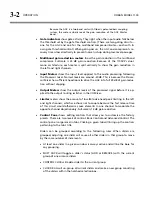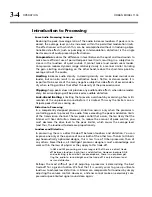
3-10
OPERATION
ORBAN MODEL 1100
•
Input Conditioning
, including defeatable highpass filtering and defeatable
phase rotation
•
Two-Band Gated AGC
, with target-zone window gating and silence gating
•
Equalization
, including high-frequency enhancement
•
Multiband Compression
in either two or five bands, depending on the proc-
essing structure
•
Low-IM Distortion Look-Ahead Limiting
Stereo Enhancement:
OPTIMOD-PC provides two different stereo enhancement
algorithms. The first is based on Orban’s patented analog 222 Stereo Enhancer,
which increases the energy in the stereo difference signal (L–R) whenever a transient
is detected in the stereo sum signal (L+R). By operating only on transients, the 222
increases width, brightness, and punch without unnaturally increasing reverb (which
is usually predominantly in the L–R channel).
The second stereo enhancement algorithm is based on the well-known “Max” tech-
nique. This passes the L–R signal through a delay line and adds this decorrelated sig-
nal to the unenhanced L–R signal. Gating circuitry similar to that used in the “222-
style” algorithm prevents over-enhancement and undesired enhancement on
slightly unbalanced mono material.
Use stereo enhancement with care if you are driving a low bitrate codec. At low bi-
trates, these codecs use various parametric techniques for encoding the spatial at-
tributes of the sound field. Stereo enhancement can unnecessarily stress this encod-
ing process.
Input Conditioning:
Before the stereo enhancer, a sample rate converter converts
the sample rate at the digital input to OPTIMOD-PC’s internal 48 kHz rate. This 48
kHz rate accommodates a 20 kHz audio bandwidth with a comfortably wide 4 kHz
transition band for the anti-aliasing filter. We are aware of no bias-controlled dou-
ble-blind studies that have ever demonstrated that sample rates higher than 48 kHz
are audibly superior to 48 kHz (or even that there is any audible difference at all).
Moreover, the noise and distortion produced by a given digital filter at 48 kHz is
about 6 dB lower than the N&D produced by a filter having the same frequency re-
sponse but operating at 96 kHz. OPTIMOD-PC uses many digital filters, both in its
equalizer section and for the crossovers in the multiband compressor. Hence, we be-
lieve that 48 kHz is the ideal rate for OPTIMOD-PC’s audio processing.
A sweepable 18 dB/octave highpass filter and a defeatable phase rotator (located
after the stereo enhancer) complete the input-conditioning block. The highpass fil-
ter is useful for production applications where it is necessary to remove low fre-
quency rumble from a recording. The phase rotator makes speech more symmetrical,
reducing its peak-to-average ratio by as much as 6 dB without adding nonlinear dis-
tortion. Hence, phase rotation can be very useful for loudness processing of speech.
Gating circuitry detects “mono” material with slight channel or phase imbalances
and suppresses enhancement so this built-in imbalance is not exaggerated. It also
Содержание OPTIMOD-PC 1100
Страница 1: ...Operating Manual OPTIMOD PC 1100 Digital Audio Processor on a PCI Sound Card Software Version 2 0...
Страница 4: ......
Страница 5: ...Operating Manual OPTIMOD PC 1100 Digital Audio Processor on a PCI Sound Card Software Version 2 0...
Страница 18: ......
Страница 54: ......






























